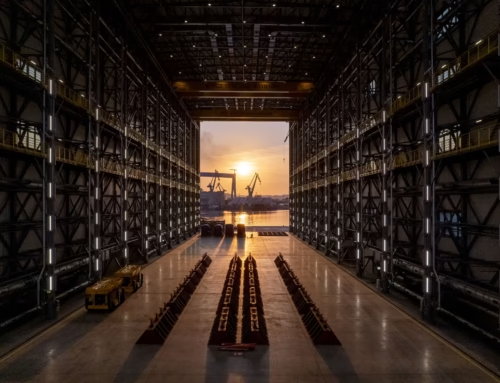Slow and Steady
Autor foto: The Ministry of Defence of Ukraine

War in Ukraine Weekly Update – Slow and Steady (29.07.-04.08.2023)
4 sierpnia, 2023


Slow and Steady
Autor foto: The Ministry of Defence of Ukraine
War in Ukraine Weekly Update – Slow and Steady (29.07.-04.08.2023)
Autor: Sebastian Czub
Opublikowano: 4 sierpnia, 2023
The Southern Front
This week, after a period of limited action, Ukrainian forces in the southern operational direction launched major assaults on Russian positions. In the area south of Velyka Novosilka Ukrainian troops managed to liberate the village of Staromaiorske. This has placed Russian positions in the neighbouring settlement of Urozhaine in a precarious position – being surrounded on almost three sides by advancing Ukrainian soldiers. The settlement will most probably be liberated in the coming days, with Russian forces and positions increasingly deteriorated. While this attack direction is still quite a few kilometres away from the primary defence lines it successfully draws out and eliminates local Russian forces. This in turn could lead to Russians not having enough manpower to properly man the main defence lines further south. This can be supported by the report of the British Ministry of Defence from August 1st which stated that local Russian units are experience having fatigue and attrition.i
However, more substantial Ukrainian actions have been happening further west in the area of Robotyne. This direction of attack aims to break through Russian lines in the western Zaporizhia Oblast and march on Tokmak and Melitopol – two key logistic hubs and Russian strongholds of the entire southern front. However, before even reaching the main lines of Russian defence Ukrainian troops have to capture the town of Robotyne. The town has been a site of fierce battles, with both sides understanding its strategic position. After several failed direct assaults on the settlement, the Ukrainian forces are now trying to bypass the town from the east – most probably in an effort to partially encircle the city and force the garrison to withdraw. In order to achieve this Ukrainian forces have committed new forces, previously held back. Many of these detachments are using western armoured vehicles, which offer greater protection than their post-soviet counterparts. Colonel Mykola Urshalovych of the Ukrainian National Guard reported that these recent assaults allowed Ukrainian forces to advance 650 metres.ii While this distance might seem insignificant, it is a key step forward in liberating Robotyne, as it endangers the settlement’s Russian garrison and their positions. Should Robotyne be captured, and its Russian garrison eliminated, Ukrainian forces will have created a breach in forward Russian defences, significantly weakened Russian forces in the area and opened the way to an assault on the primary defensive lines in the south.
The Eastern Front
On the eastern front the Ukrainian forces are also experiencing a surge. In the Bakhmut area Ukrainian troops are continuing the operation to encircle the city. South of Bakhmut Ukrainian forces have entered Klishchiivka and Andriivka. The two settlements are protecting Bakhmut’s southern flank, and should they be taken the Russian communication line to Bakhmut would be severely hindered and open the city to attacks from the south. The importance is not unknown to the Russians, who have been pouring reinforcements into the area in an effort to stop the Ukrainian advance. This has partially worked with the momentum of the Ukrainian attack somewhat stymied. Despite this the situation of Russian troops in the area remains extremely difficult. The Ukrainian attacks north of Bakhmut have been similarly hindered, with Russian soldiers fighting for every inch of ground.
The slower pace of Ukrainian operations in Bakhmut is most probably tied to Russian offensive operations along the Lyman-Svatove-Kupyansk line. The Russian attacks in these directions have achieved some territorial gains. The most significant one was the crossing of the Zherebets river between the settlements of Novovodiane and Raihorodka. Heavy fighting took place in the area, and the reports from the area are limited. According to Russian sources, Moscow’s troops advanced, and are holding positions as far as 5 kilometres west of the river, reaching the village of Novoiehorivka.iii Though, there is no confirmation of this from Ukrainian sources. It is quite possible however, that Russian forces achieved some gains as Ukrainian forces have been reportedly forced to transition reinforcements into the area. This could potentially explain the slower pace of Ukrainian operations in Bakhmut. Furthermore, over the past weeks Russian forces have been slowly creeping towards Kupyansk. The encroachment of Russian forces, including the premier 1st Guards Tank Army, along the Lyman-Svatove-Kupyansk line has pressured Ukrainian forces on the eastern front. Whether the Russian operations were preparation for a major offensive effort in the area or were simply used to draw Ukrainian focus away from Bakhmut remains to be seen.
The slow and steady approach
It has been nearly two months since the start of the Ukrainian offensive. In those eight weeks of fighting the Ukrainian armed forces failed to achieve a significant breakthrough in any of their operational directions. This led to a number of media sources, experts, and the general public to state that the offensive had failed. This has been further fuelled by footage circulating in the media showing Ukrainian losses during offensive operations. Such judgement however, is ill advised. Ukrainian forces are facing very considerable Russian defensive lines and breaching them is no easy task. In order to do so Ukrainian forces have to create favourable conditions. This is being done by systematically exploiting weak spots in Russian lines and dealing as many casualties to the Russian forces as possible. This can be seen both in the example of Robotyne, in the area of Velyka Novosilka, and Bakhmut. Russian positions are being dismantled, and openings are being created through which Ukrainian troops can move in and engage the Russians on more favourable conditions. Such operations take time and will result in casualties and loss of equipment, due to the very hazardous nature of these operations, but that is not an indication of a failed offensive.
Poland – Belarus border incidents
Also worth mentioning is the rising pressure along the Polish – Belarussian border. The arrival of significant numbers of Wagner mercenaries to Belarus, including in close proximity to the Polish border has rung alarms in the country. The threat of Russian backed hybrid operations in this area has been widely discussed and examined by Polish authorities, who decided to bolster the security measures along the border by transitioning military forces into the area. The tension rose further when two armed Belarussian helicopters temporarily crossed the Polish border.iv The incident sparked outrage in Poland and further enticed the fears of potential hostile operations carried out either by Belarus, Wagner Group, or other Russian backed actors. The Polish government assured that the border is being protected however, the increase of tensions might cause further escalation. Should this situation spiral further it might prove disastrous for both countries, as well as Ukraine which relies on Poland as a logistics and repair hub for western equipment.
Conclusions
The situation on the frontlines of Ukraine is developing both with noticeable successes for the Ukrainian forces, as well as mounting pressure from the Russian forces in the northern section of the eastern front. The Ukrainian slow and steady approach is grinding down the Russian defences, and while it may not be as easily perceivable as quick strikes and victories, it seems to be working. The key consideration here however is, whether the Ukrainian forces will manage to achieve their goals before the Russians play their own hand. The situation along Lyman-Svatove-Kupyansk line could suddenly become critical for Ukrainian forces, and force them to abandon their own offensive efforts, which could lead to another autumn period of mudfloods and attritional trench warfare.
Author: Sebastian Czub, analyst at Casimir Pulaski Foundation
iMinistry of Defence of the United Kingdom, Twitter, August 1, 2023, https://twitter.com/DefenceHQ/status/1686249521964085248?s=20.
iiVolodymyr Skorostetskyi, “Микола Уршалович: Артилерія НГУ виконала понад 500 вогневих завдань, здобуто ворожі трофеї”, ArmyInform, August 3, 2023, https://armyinform.com.ua/2023/08/03/mykola-urshalovych-artyleriya-ngu-vykonala-ponad-500-vognevyh-zavdan-zdobuto-vorozhi-trofeyi/.
iiiKateryna Stepanenko el al., “Russian Offensive Campaign Assessment, August 3, 2023”, Press ISW, August 3, 2023, https://www.understandingwar.org/backgrounder/russian-offensive-campaign-assessment-august-3-2023.
ivIzabela Kacprzak, and Rusłan Szoszyn, “Śmigłowce w polskiej przestrzeni powietrznej. „Moskwa pcha Białoruś do eskalacji z Polską””, Rzeczpospolita, August 3, 2023, https://www.rp.pl/konflikty-zbrojne/art38895511-smiglowce-w-polskiej-przestrzeni-powietrznej-moskwa-pcha-bialorus-do-eskalacji-z-polska.






